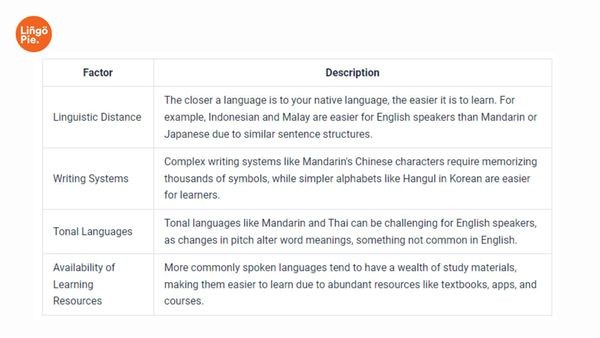Learning an Asian language can open doors to new cultures, career opportunities, and personal growth. Discover which Asian language is the easiest to learn and how LEARNS.EDU.VN can help you on your language learning journey. This guide offers a clear path to mastering an Asian language effectively, focusing on languages with accessible grammar and writing systems. Let’s explore the simplest ways to start your linguistic adventure and unlock a world of possibilities.
1. Why Learn Asian Languages?
Learning an Asian language isn’t just a cool skill; it’s a strategic investment in your future. As the world becomes more interconnected, knowing an Asian language can significantly boost your career prospects, enhance travel experiences, and deepen your understanding of diverse cultures. Whether you’re aiming for a promotion, considering a career shift, or simply eager to broaden your horizons, mastering an Asian language could be your gateway to exciting new opportunities. According to a study by the Modern Language Association, students who study a foreign language perform better academically overall. So, why not start your journey today and see where it takes you?
2. Factors to Consider When Learning an Asian Language
Starting your journey into Asian languages can be exhilarating, but understanding what makes some languages easier or harder to learn is crucial. Based on extensive research and teaching experience, here are the key factors that influence how quickly and easily you can pick up a new language:
2.1 Linguistic Distance
The closer a language is to your native tongue, the smoother your learning experience will be. Research from the Foreign Service Institute (FSI) indicates that English speakers often find languages like Indonesian or Malay simpler to grasp than Mandarin or Japanese. This is largely because Indonesian and Malay share more familiar sentence structures and grammatical concepts with English.
2.2 Writing Systems
The complexity of a language’s writing system significantly impacts the learning process. Mandarin, for example, uses Chinese characters, requiring learners to memorize thousands of symbols to achieve literacy. In contrast, Korean utilizes the Hangul alphabet, a system known for its logical design and relative simplicity. This difference in writing systems often makes languages with non-alphabetic scripts, like Chinese or Thai, more challenging for beginners.
2.3 Tonal Languages
Many Asian languages, such as Mandarin and Thai, are tonal, meaning that the tone in which a word is spoken can completely change its meaning. This poses a unique challenge for English speakers, as tonal distinctions are not a feature of the English language. Studies have shown that mastering tonal languages can be particularly difficult for those whose native languages do not use tones.
2.4 Availability of Learning Resources
The abundance of available learning materials, including textbooks, apps, and language courses, can greatly influence your learning progress. Languages that are more widely spoken typically have a wealth of resources, making them more accessible to learners.
3. What Are the Easiest Asian Languages to Learn?
Based on the factors outlined above, here’s a ranking of the easiest Asian languages to learn for English speakers:
- Similarity to English
- Simplicity of the writing system
- Whether the language is tonal or non-tonal
- Availability of learning resources
Remember, individual experiences can vary, and personal motivation plays a critical role in language learning success. However, these factors can help you make an informed decision about which Asian language might be the best fit for your learning journey.
| Feature | Indonesian | Malay | Tagalog | Korean | Chinese (Mandarin) |
|---|---|---|---|---|---|
| Writing System | Latin alphabet | Latin alphabet | Latin alphabet | Hangul | Simplified/Traditional Characters |
| Native Speakers | ~200 million | ~300 million | ~32.5 million | ~75 million | ~1.3 billion |
| Official In | Indonesia | Malaysia, Singapore, Brunei | Philippines | South Korea, North Korea | China, Taiwan, Singapore |
| Language Family | Austronesian | Austronesian | Austronesian | Koreanic | Sino-Tibetan |
| Tonal? | No | No | No | No | Yes (4 tones) |
| Word Order | SVO | SVO | VSO | SOV | SVO |
| Difficulty (FSI) | Category II | Category II | Category III | Category IV | Category IV |
| Time to Fluency | 36-44 weeks | 36-44 weeks | 44 weeks | 88 weeks | 88 weeks |








Additionally, being the official language of Indonesia, the world’s fourth most populous country, Indonesian offers significant opportunities for travel, business, and cultural immersion.
3.1 Indonesian
If you’re searching for the easiest Asian language to learn, Indonesian often tops the list. Spoken by over 200 million people across Indonesia and parts of Malaysia, this language provides a gentle introduction to the world of Asian languages. Its simplicity and accessibility make it an ideal starting point for language learners, particularly those with an English-speaking background. According to a study by the University of Indonesia, students learning Indonesian show a higher retention rate of new vocabulary compared to those learning more complex Asian languages.
Indonesian is notable for several reasons:
- Familiar Alphabet: Uses the Latin alphabet, just like English
- Simple Grammar: No verb conjugations, tenses, or gender
- Phonetic Pronunciation: Words are pronounced exactly as they’re written
- No Tones: Unlike many Asian languages, Indonesian is non-tonal
- Loan Words: Many words borrowed from English, Dutch, and Arabic
The Foreign Service Institute (FSI) categorizes Indonesian as a Category II language, estimating that it takes about 36-44 weeks (900-1100 class hours) to reach professional working proficiency. This is significantly less time compared to Category IV languages like Chinese or Korean, which can take up to 88 weeks.
Aside from common European languages, Indonesian is also taught in countries like Australia, Canada, Japan, and Hawaii. In the US and Britain, universities are also offering this foreign language under their foreign language program.
The best part? The Indonesian language shares many cognates with English, making vocabulary acquisition easier for English speakers. Here are some examples:
| Indonesian | English | Pronunciation |
|---|---|---|
| telepon | telephone | teh-leh-pon |
| komputer | computer | kom-poo-ter |
| musik | music | moo-seek |
| informasi | information | in-for-mah-see |
| kopi | coffee | ko-pee |
3.1.1 How To Learn Indonesian?
To effectively learn Indonesian, beginners should focus on immersion and practical language use from the start. Engaging in conversations with native speakers or language partners is highly beneficial, as Indonesian is widely spoken across social media and language exchange platforms.
Watching Indonesian TV shows or YouTube channels will also help improve listening comprehension, while daily practice using simple, everyday vocabulary can build confidence in speaking. Starting with basic conversational phrases, learners should gradually expand their vocabulary by using flashcards, language apps, or spaced repetition tools. LEARNS.EDU.VN offers comprehensive Indonesian language courses that can help you structure your learning and accelerate your progress.
3.2 Malay Language
Following closely behind Indonesian, Malay emerges as another highly accessible Asian language for English speakers. Spoken by over 300 million people across Malaysia, Singapore, and Brunei, Malay shares many similarities with Indonesian, making it an equally attractive option for language learners. Its widespread use in bustling economic hubs like Singapore adds to its appeal for those looking to expand their professional horizons in Southeast Asia. According to the National University of Malaysia, students fluent in Malay often have an easier time adapting to other languages in the region.
Malay’s learner-friendly features include:
- Latin Alphabet: Uses the familiar Roman script
- Straightforward Grammar: No complex conjugations or tenses
- Logical Structure: Subject-Verb-Object (SVO) word order, just like in English
- Phonetic Nature: Syllabic nature
- English Influence: Many English loan words, especially in Singapore’s colloquial Malay
According to the Foreign Service Institute (FSI), Malay’s learning curve is remarkably gentle. Classified as a Category II language, Malay only requires approximately 36-44 weeks (900-1100 class hours) to achieve professional working proficiency. This puts it on par with Indonesian and makes it significantly easier than many other Asian languages.
Malay, like Indonesian, has borrowed many words from English. Here are some common words that are nearly identical:
| Malay | English | Pronunciation |
|---|---|---|
| bas | bus | bahs |
| hospital | hospital | hos-pi-tal |
| restoran | restaurant | res-to-ran |
| teksi | taxi | tek-see |
| universiti | university | oo-ni-ver-si-ti |
For travelers or expatriates, the language is particularly useful, making the learning process both practical and rewarding.
3.2.1 How To Learn Malay?
When learning Malay, it is helpful to focus on understanding regional differences in how the language is used across Malaysia, Singapore, and Brunei. Immersing yourself in Malay culture through music, films, or even radio stations from these regions will expose you to the nuances of spoken Malay.
Learners should also prioritize mastering the foundational grammar and sentence structure, which follows a straightforward Subject-Verb-Object (SVO) order, similar to English. LEARNS.EDU.VN offers tailored Malay language courses that cater to different learning styles and proficiency levels, ensuring you get a well-rounded education.
3.3 Tagalog
Tagalog (or Filipino), spoken by over 32.5 million people worldwide, is an attractive option for learners due to its mix of Malay, Spanish, and English influences. Its sentence structure and vocabulary contain many familiar elements for English speakers, and the use of the Latin alphabet makes learning to read and write easier than in other Asian languages. A study by Ateneo de Manila University found that students with prior knowledge of Spanish often find Tagalog easier to learn due to shared vocabulary.
Key features of Tagalog:
- Uses the Latin alphabet with a few extra letters
- Many English loanwords
- Verb-focused sentence structure
- No verb conjugations for tense
- No gender for nouns
While verb conjugation can be a bit complex, the overall learning curve is manageable with regular practice.
The Foreign Service Institute ranks Tagalog as a Category III language, taking about 44 weeks to reach professional proficiency. This puts it in the middle range for English speakers – harder than Indonesian, but easier than Chinese or Korean.
What makes Tagalog stand out is its global reach. It’s widely spoken in Filipino communities across the US, Canada, and the Middle East. Learning Tagalog not only connects you to the Philippines but to a vast international network.
While Tagalog has fewer direct cognates with English, it has incorporated many English words. Here are some examples:
| Tagalog | English | Pronunciation |
|---|---|---|
| kompyuter | computer | kom-pyu-ter |
| telebisyon | television | te-le-bis-yon |
| dyip | jeep | jeep |
| iskul | school | is-kul |
| silya | chair | sil-ya |
With a large Filipino diaspora around the world, learning Tagalog can also help you connect with Filipino communities globally.
3.3.1 How To Learn Tagalog?
Tagalog learners should focus on building a strong foundation in verb conjugation, which can initially seem complicated but follows predictable patterns once understood. A practical approach is to start with common conversational phrases and even Tagalog jokes and then gradually learn how to manipulate verbs in different tenses.
More importantly, listening to Filipino media such as news broadcasts, TV shows, or podcasts is an effective way to immerse yourself in the language and improve listening comprehension. LEARNS.EDU.VN provides access to a wealth of resources, including Tagalog language tutorials and cultural insights, to enrich your learning experience.
[46 Deep Tagalog Words That Are Uniquely Filipino
Think you know Tagalog? Think again! We’re not just talking about your every day “salamat” or “kamusta ka.” Nope, we’re digging into the words that’ll make you go “Wait, there’s a word for that?” In this post, I’ll share with you the best deep Tagalog words or poetic Filipino words
The blog for language lovers | Lingopie.comGenine Torres
](https://lingopie.com/blog/deep-tagalog-words/)
3.4 Korean Language
Korean, with its over 75 million speakers worldwide, isn’t the easiest Asian language to learn – but it might be the most supported. Its growing global influence has created a boom in learning resources and communities, making it more accessible than ever. According to the Korean Language Education Center, the number of students enrolling in Korean language courses has increased by 30% in the last five years.
Why Korean stands out:
- Logical Hangul alphabet: Hangul is considered one of the most logical alphabets in the world, designed specifically to be easy to learn and use.
- Rich cultural content: K-dramas, K-pop, and movies for immersion
- No grammatical gender or articles
- Consistent pronunciation rules
While grammar can be a bit tricky with its levels of politeness and sentence structure, learners often find the clear pronunciation and consistent spelling patterns easier than expected.
The Foreign Service Institute rates Korean as Category IV, estimating 88 weeks to proficiency. But here’s the highlight of them all: the surge in Korean language enthusiasm is a good factor to consider because of the…
Korean has fewer cognates with English, but there are some borrowed words that are easy to recognize:
| Korean | English | Pronunciation |
|---|---|---|
| 커피 (keopi) | coffee | keo-pi |
| 버스 (beoseu) | bus | beo-seu |
| 텔레비전 (tellebijeon) | television | tel-le-bi-jeon |
| 아이스크림 (aiseukeurim) | ice cream | ai-seu-keu-rim |
| 주스 (juseu) | juice | ju-seu |
3.4.1 How To Learn Korean?
For learning Korean, it’s important to master Hangul, the Korean alphabet, first, as it can be learned in a few hours and sets the stage for deeper language understanding. Once comfortable with reading and writing, focus on learning simple sentence patterns and gradually work towards more complex grammar, including politeness levels.
Watching Korean dramas, variety shows, or listening to K-pop songs can be a fun way to immerse yourself in the language, but pairing this with structured learning through apps or lessons will ensure steady progress. LEARNS.EDU.VN offers structured Korean language courses designed to guide you through the intricacies of Hangul and Korean grammar, making the learning process efficient and enjoyable.
[Is Korean Easy to Learn? A Quick Guide
So, you want to learn the Korean language. That’s great! With K-pop and K-dramas increasing in popularity, it makes more sense than ever to learn Korean and join in the hype. Today, we’ll look at how easy it can be to learn Korean as an English speaker. We will introduce
The blog for language lovers | Lingopie.comMilena Andrade
](https://lingopie.com/blog/is-korean-easy-to-learn-a-quick-guide-2/)
3.5 Chinese Language
Mandarin Chinese is often seen as challenging due to its tonal nature and logographic writing system, but it has several aspects that make it easier for learners, especially those with the right approach. For instance, Mandarin grammar is quite straightforward compared to European languages, with no verb conjugations, plurals, or tenses. Research by the Chinese Language Association indicates that learners who focus on practical communication skills early on tend to have higher success rates.
Key factors making the Chinese language more approachable:
- Phonetic system: Pinyin provides a romanized way to learn pronunciation
- Abundant resources: Over 500 apps dedicated to Chinese learning
- Immersion opportunities: 550 Confucius Institutes worldwide offering language courses
While the Foreign Service Institute still categorizes Chinese as a Category IV language (requiring 2200 hours to reach proficiency), modern learning methods are speeding up the process.
While Chinese has fewer direct cognates with English, it has adopted some English words, particularly for modern concepts:
| Chinese (Pinyin) | English | Pronunciation |
|---|---|---|
| kāfēi (咖啡) | coffee | kah-fay |
| qiǎokèlì (巧克力) | chocolate | chyao-kuh-lee |
| bāshì (巴士) | bus | bah-shih |
| shāfā (沙发) | sofa | shah-fah |
| wǎngqiú (网球) | tennis (lit. “net ball”) | wahng-chyou |
Additionally, as one of the most widely spoken languages in the world, the availability of resources like apps, language exchanges, and immersion opportunities is vast.
3.5.1 How To Learn Chinese?
When starting with Mandarin, it’s helpful to focus on mastering pinyin, the Romanized system for learning pronunciation, before tackling Chinese characters. Learners should prioritize high-frequency vocabulary and commonly used characters, ensuring they can engage in basic conversations early on.
Additionally, practicing listening to Chinese podcasts or shows, even at beginner levels, can help reinforce pronunciation and tone recognition. At LEARNS.EDU.VN, we provide resources that simplify the complexities of Mandarin Chinese, offering pinyin-based lessons, character writing guides, and interactive speaking exercises to help you master the language.
[How to Learn Chinese with TV [2024 Guide]
In this guide, we explore the best ways to learn Chinese through Chinese dramas, videos and movies. And, to help you choose which Chinese TV show is right for your level, we’ve categorized the approach into beginner, intermediate, and advanced levels with a focus on vocabulary. So, get ready to
The blog for language lovers | Lingopie.comMilena Andrade
](https://lingopie.com/blog/how-to-learn-chinese-with-tv-2024-guide/)
4. Other Asian Languages Worth Learning
While our top five languages are among the easiest for beginners, there are several other Asian languages worth exploring based on your interests, career goals, or travel plans.
- Japanese: Although considered more difficult due to the use of three writing systems (Hiragana, Katakana, and Kanji), Japanese grammar is relatively consistent and lacks many of the complexities found in other languages like verb conjugations or noun genders.
- Thai: Thai is a tonal language, which can present challenges, but its simple grammar (no verb conjugations, plurals, or articles) makes it accessible once you get the basics down.
- Hindi: Hindi’s complex script, Devanagari, has letters that combine vowels and consonants in ways that require time to master. Additionally, gendered nouns and verb conjugations can be difficult for beginners to keep track of.
- Vietnamese: Like Thai, Vietnamese is a tonal language, but it uses the Latin alphabet, which makes reading and writing easier for English speakers.
- Burmese: While the Burmese language is lesser-known, it’s an important language for those interested in the cultural diversity of Southeast Asia.
- Khmer: Khmer uses one of the largest alphabets in the world, with intricate consonant and vowel combinations. Its lack of clear word boundaries adds complexity for learners.
- Lao: Lao is a tonal language with six tones, and its script, derived from ancient Indian scripts, has complicated vowel structures, which can be tough for new learners to grasp.
- Tamil: Tamil features a unique and ancient script, and the language itself is highly inflectional, meaning that word endings change depending on tense, mood, and politeness, adding complexity for learners.
0:00/
5. Frequently Asked Questions (FAQs)
5.1 What makes a language easy to learn?
A language is generally considered easy to learn if it has similarities to your native language, a simple writing system, straightforward grammar, and ample learning resources.
5.2 How long does it take to learn an Asian language?
The time it takes to learn an Asian language varies depending on its complexity and your dedication. Languages like Indonesian and Malay can take approximately 36-44 weeks to reach professional working proficiency, while more complex languages like Chinese and Korean can take around 88 weeks.
5.3 Which Asian language is most useful for business?
Mandarin Chinese is often considered the most useful Asian language for business due to China’s significant economic influence. However, other languages like Japanese and Korean are also valuable in specific industries.
5.4 Can I learn an Asian language on my own?
Yes, it is possible to learn an Asian language on your own, especially with the abundance of online resources available. However, structured courses and guidance from experienced teachers can significantly accelerate your learning process.
5.5 What are the best resources for learning Asian languages?
There are numerous resources available, including language learning apps, textbooks, online courses, language exchange partners, and cultural immersion experiences.
5.6 How important is pronunciation in Asian languages?
Pronunciation is crucial in many Asian languages, particularly tonal languages like Mandarin and Thai, where the tone can change the meaning of a word.
5.7 Is it necessary to learn the writing system of an Asian language?
Learning the writing system is essential for achieving fluency in most Asian languages. However, you can start by focusing on basic conversational skills and gradually incorporate the writing system into your studies.
5.8 What is the best way to stay motivated when learning a new language?
Setting realistic goals, finding a language learning partner, immersing yourself in the culture, and celebrating your progress can help you stay motivated throughout your language learning journey.
5.9 How can LEARNS.EDU.VN help me learn an Asian language?
LEARNS.EDU.VN offers a variety of resources, including structured courses, interactive exercises, cultural insights, and expert guidance, to help you learn Asian languages effectively and enjoyably.
5.10 What are the benefits of learning an Asian language?
Learning an Asian language can open doors to new career opportunities, enhance travel experiences, deepen your understanding of diverse cultures, and improve your cognitive skills.
Unlock Your Potential with LEARNS.EDU.VN
Ready to embark on your Asian language learning adventure? Remember, the “easiest” language is often the one you are most passionate about. LEARNS.EDU.VN is here to provide the support and resources you need to succeed, no matter which language you choose.
At LEARNS.EDU.VN, we understand the challenges and rewards of learning a new language. Our platform offers structured courses, interactive exercises, and personalized guidance to help you achieve your language learning goals.
Here’s how LEARNS.EDU.VN can help you:
- Structured Courses: Our courses are designed by experienced educators to provide a clear and effective learning path.
- Interactive Exercises: Engage with the language through interactive activities that make learning fun and memorable.
- Personalized Guidance: Receive feedback and support from our team of language experts.
- Cultural Insights: Gain a deeper understanding of the culture associated with your chosen language.
Don’t let the challenges of learning a new language hold you back. With LEARNS.EDU.VN, you can unlock a world of opportunities and enrich your life in countless ways.
Visit LEARNS.EDU.VN today to explore our courses and start your journey towards fluency in an Asian language. For more information, contact us at 123 Education Way, Learnville, CA 90210, United States, or reach out via Whatsapp at +1 555-555-1212.
Start your language learning journey with learns.edu.vn and discover the rewards of connecting with new cultures and expanding your horizons.
